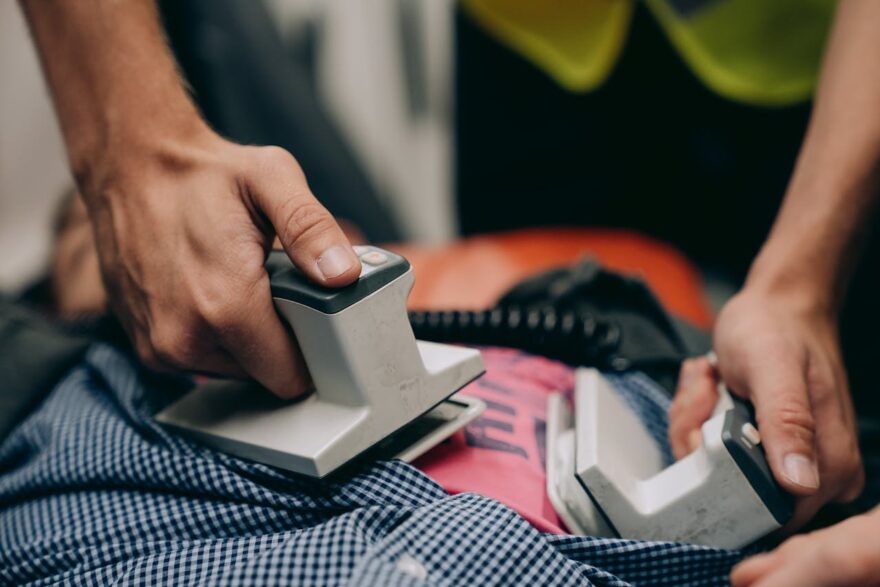Sudden cardiac arrest can strike without warning and is a serious emergency. When the heart suddenly stops beating, time is critical. Quick action is needed to save a life, and this is where an Automated External Defibrillator (AED) becomes vital. An AED is a portable device designed to deliver a shock to the heart, helping it return to a normal rhythm.
AEDs are made for easy use, featuring clear voice instructions and visual cues to guide even the untrained through the necessary steps. Found in many public locations like airports and sports arenas, having an AED nearby increases the chance of survival dramatically. Anyone can make a difference by learning how to use an AED.
While having access to an AED is important, understanding how they function and the significance of proper training ensures we can respond effectively to cardiac emergencies. Every second counts, and the presence of an AED can mean the difference between life and death.
Understanding Sudden Cardiac Arrest and the Role of AEDs
Sudden cardiac arrest happens when the heart abruptly stops pumping blood. It’s different from a heart attack, which is caused by blocked blood flow. In cardiac arrest, the heart’s electrical system malfunctions, causing it to quiver or stop entirely. This leads to a loss of blood flow to the brain and other vital organs, and without quick help, it can be fatal within minutes.
An AED is a critical tool in such emergencies. The device analyzes the heart’s rhythm and, if necessary, delivers a shock to help restore a normal rhythm. AEDs are crucial because they enable immediate action. Every minute without treatment reduces the chances of survival by about 10%. This makes AEDs indispensable in public spaces where medical help might not be nearby.
The presence of AEDs in places like malls, schools, and gyms enhances the ability to respond quickly. Using an AED as soon as possible increases the likelihood of survival. Therefore, understanding the role of AEDs is essential in ensuring that more people can respond effectively in cardiac emergencies.
Step-by-Step Guide: Using an AED During an Emergency
Knowing how to use an AED can help save lives. Here’s a simple step-by-step guide to using an AED during a cardiac emergency:
1. Ensure Safety: Check the scene for safety before approaching the person in distress.
2. Call for Help: Dial 911 or ask someone nearby to call for emergency services.
3. Turn on the AED: Open the AED’s lid or press the power button. The device will start giving voice instructions.
4. Attach the Pads: Place the adhesive electrode pads on the person’s bare chest. Follow the diagram on the pads for correct placement.
5. Let the AED Analyze: Once the pads are in place, the AED will check the heart’s rhythm. Don’t touch the person during analysis.
6. Deliver Shock if Advised: If the AED indicates a shock is needed, ensure no one is touching the person, then press the shock button.
7. Continue CPR: After delivering a shock, or if no shock is advised, continue CPR until emergency responders arrive.
Understanding these steps and acting calmly can help save a life during a cardiac emergency. Practice and familiarity with AED use increase the chances of a positive outcome.
The Importance of AED Training and Regular Practice
Having access to an AED is crucial, but knowing how to use it effectively requires training. Many communities and organizations provide AED and CPR training, which helps build confidence. Training ensures you perform each step accurately when every second counts.
AED courses typically cover:
– How to recognize cardiac arrest symptoms
– The sequence of steps using an AED
– Performing CPR alongside AED use
– Safety precautions and when to call for help
Regular practice is also key. Having routine drills or refresher courses helps keep skills sharp. Practicing in a controlled environment prepares you for real emergencies. It also reduces panic and improves response times.
Being trained in AED use means you are ready to act quickly and effectively. Joining a training program enhances your readiness and can make a significant difference in saving a life. Consistent practice and education create a safer community overall.
Increasing AED Accessibility to Improve Public Safety
Improving AED accessibility is vital for public safety. Placing AEDs in strategic, easy-to-reach locations ensures they are available when needed most. Whether in schools, gyms, or workplaces, accessible AEDs empower bystanders to help without delay.
Here are ways to enhance AED accessibility:
1. Identify High-Traffic Areas: Install AEDs in places where crowds gather, such as malls and transportation hubs.
2. Promote Awareness: Use signs and public announcements to inform people about AED locations.
3. Community Programs: Encourage local businesses and organizations to participate in AED donation or sponsorship programs to expand availability.
4. Regular Maintenance: Ensure AEDs are functional by performing routine checks and replacing batteries and pads as needed.
Increasing accessibility requires a community effort. By strategically placing AEDs and raising awareness, we boost the chances of a lifesaving intervention. Ensuring everyone knows where to find and how to use AEDs can transform response outcomes in public spaces.
Conclusion
AEDs prove invaluable during cardiac emergencies by providing lifesaving interventions quickly. Understanding and training on these devices improve chances when seconds matter. Accessibility broadens the possibilities of immediate response, making communities safer and more prepared.
Citywide CPR is committed to equipping communities with the tools and knowledge needed to respond effectively. Whether you’re looking to train your team or enhance onsite AED access in your area, our comprehensive programs cater to your needs. Partner with Citywide CPR to ensure the best response during a cardiac emergency and help save lives today.






